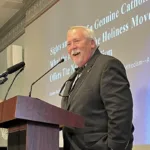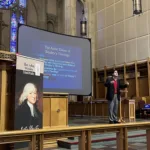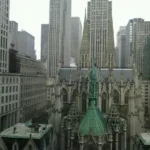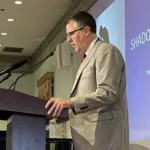The following article appeared on the American Spectator website and was reposted with permission.
To drive across our great nation is to rediscover its beauty and greatness. (Photo credit: American Spectator) |
To drive across America is to rediscover its beauty and greatness. Anxious to see what I’ve never seen before and to avoid nightmarish air travel, I recently drove 4,500 miles round trip from Washington, D.C. to Bozeman, Montana. The destination was an edifying conference for “religious leaders” on environmental economics, hosted by the Foundation for Research on Economics and the Environment. But the drive, punctuated by an interesting historical, park or museum stop each day, was as uplifting as the terminus.
Thanks to Sirius radio, I was wearyingly informed on every step of my journey about the escalating debt limit crisis. But spectacular scenery and sites forestalled undue pessimism. Not even the endless toll roads of the upper Midwest could depress spirits on such a drive.
First stop was Thomas Edison’s birthplace home in charming Milan, Ohio. Built by Edison’s Canadian immigrant father over 150 years ago, the brick cottage was conveyed as is by Edison’s sister to the museum. The furniture is original, in as the family Bible listing Edison’s birth. Inventor of the light bulb, phonograph and motion pictures, Edison helped birth modernity and presided over perhaps America’s most transformative age. The surrounding neighborhood is preserved partly as Edison as a boy would have seen it, thanks to protective museum docents. Enjoyably, even the nearby Methodist church is named for Edison, who is a patron saint of technology.
Next stop was Frank Lloyd Wright’s magnificent Taliesin estate in the rolling dairy country of Wisconsin. Sprawlingly perched against a hilltop, the home was a fitting stage for America’s best known if not greatest architect. Built on the land of his Welsh ancestors, the house’s history was as dramatic as its builder’s. Lloyd designed it after leaving his first wife, and there installed his mistress and her children. In Wright’s absence, a deranged servant axe murdered them and several others in 1914 while also burning the house.
Robustly buoyant after calamity, Wright found future consorts, and also rebuilt the house again after suffering a second, accidental fire. His final wife managed the house after Wright’s 1959 death. She also invited Joseph Stalin’s refugee daughter to live there, convinced Svetlana Stalin was the partial reincarnation of her own deceased daughter, also named Svetlana. And Mrs. Wright successfully orchestrated her widower son-in-law’s marriage to the new Svetlana. Frank Lloyd Wright’s personal life was as messy as his genius was grand, and he was unpopular in this region for routinely ignoring his debts. But Taliesin, which now houses architectural students, is a fitting monument to his better side.
Hormel’s Spam Museum in Austin, Minnesota, was my next stop. Smoothly crafted from a seemingly unlimited budget, the splashy museum fulsomely chronicles the history of the meatpacking Hormel Family as well as the famously canned hybrid meat most popularized during World War II. A letter from a post-presidential Dwight Eisenhower to Hormel recalls Ike’s own wartime Spam diet, which he confessed did not always elicit kind thoughts at the time. The museum includes an unashamedly promotional film full of advertising jingoes that might even provoke reluctant smiles from a grim, anti-capitalist.
After a brief viewing of the Corn Palace in Mitchell, North Dakota, where it was over 100 degrees, as well as a failed attempt to see the Senator George McGovern Museum at Dakota Wesleyan University, I arrived at Mount Rushmore right before its 10pm closing. The viewing area was almost empty, there were no signs of Eva Marie Saint or Cary Grant (whose North by Northwest Alfred Hitchcock film dramatically concluded there), and a friend by text warned me to leave if the illuminated giant presidential faces began to speak. Fortunately, they remained stoically silent, and I was able to absorb the spectacle in silence.
Next morning I got off course and, in a wonderful accident, found Devil’s Tower in Wyoming. It’s a giant volcanic neck supposedly popular with extraterrestrials, at least according to Hollywood. Walt Disney’s 1970’s Escape to Witch Mountain about child aliens was filmed there, as was more famouslyClose Encounters of the Third Kind,” in which Richard Dreyfuss manically kept constructing versions of the mountain tower out of mud or mashed potatoes, until he found the real place, along with an alien mother ship.
Late in the day I arrived at the Little Big Horn, whose rolling grassy hills are eerily beautiful. And they are still preserved much as General George Armstrong Custer and his doomed cavalry command would have remembered. There are stone markers where each of the slain cavalrymen’s corpses was discovered. Later they were reburied at an adjoining national veterans’ cemetery. Part of the battlefield is still privately owned, on which I encountered two friendly mounted tribesmen. Sadly, a shabby casino is right outside the park.
I arrived in Bozeman, Montana, at 3am, naturally in the dark, unprepared for the stunning landscape unveiled next morning outside the 1920’s era hotel, built by the railroads to service Yellowstone National Park. A local informed me that Ted Turner, whose ranch is nearby, does not much impress Bozeman. One restaurant declined to allow him to skip ahead of a line. And another restaurateur, a Vietnam War veteran, reputedly asked Turner and then wife Jane Fonda to leave. Presumably fellow nearby rancher Oprah Winfrey has fewer confrontations.
Yellowstone National Park presents one incredible vista after another, climaxing with geysers and lakes of boiling mud, along with an occasional elk visit. I did a 5 mile hike, anxiously mindful of an unfortunate tourist killed by a protective momma grizzly just weeks before. Old Faithful delivered its water spout on schedule. Grand Teton National Park, the next visit, was equally amazing. Its snow-topped mountains are recognizable as the backdrop of the classic 1953 western Shane with Alan Ladd. On Sunday I worshipped at famous 1920s Episcopal log Chapel of the Transfiguration, in which a picture glass window behind the altar showcases the mountains. Benches outside the chapel windows accommodate an overflow crowd. A tourist bus oddly appeared just as we walked forward for communion, and the tourists unthinkingly joined the line while taking pictures, seemingly unaware they were at an active church.
Endless wide open country across Wyoming finally emptied me into Colorado and a brief visit to lively Denver, where there are endless options for outdoor dining in the lively downtown even late on a weeknight. After hours of driving across flat country, my next stop was the Eisenhower Library and Museum in Abilene, Kansas. Ike’s modest but ample boyhood home is carefully preserved. The accompanying museum superbly includes his World War II Cadillac painted camouflage. His driver was British military chauffeur and alleged wartime mistress Kay Summersby. A 1979 video of presidential widow Mamie Eisenhower is showcased, with an irritating Barbara Walters pressing Mamie whether she was “wooried” about their marriage during the war. Taking the unsubtle hint, Mamie adamantly rejected any such notion.
More driving across Kansas landed me in Lawrence, founded by abolitionist New Englanders in the 1850s to preserve Kansas from slavery. Quaintrill’s Raiders’ infamously attacked the town in 1863, massacring about 200 men. Many buildings burned, but a few still survive. Nearby is Lecompton, Kansas, early capital of Kansas Territory. The original building where the infamous Lecompton Constitution was born is now a museum. Pledging Kansas to slavery, that constitution was a main topic in the Lincoln-Douglas debates and helped elect Lincoln eventually as president. I sped overnight through St. Louis, passing the illuminated great Arch, and arriving at New Harmony, Indiana. Founding the village in the early 19th century, the Harmonites were a German pietist sect who were celibate and channeled their energy into thrifty industry and charming architecture, much of which remains as a historical park, lodging and a very pleasant restaurant.
Speeding through Kentucky next, I visited majestic White Hall outside Lexington, the home of abolitionist statesman Cassius Marcellus Clay, cousin to Henry Clay and friend to Abraham Lincoln, whom he served as Ambassador to Russia during the Civil War. Blustery and courageous, his anti-slavery views in a slave state kept him in perpetual combat. As an octogenarian he married a 15 year old girl; the marriage was short lived. His estate, perhaps the first in Kentucky with an indoor toilet, is magnificent.
That evening I dined in an over 200-year-old log cabin in Lewisburg, West Virginia, a very pretty historic town, once subject to Indian attacks, near the famous Greenbrier Resort. There were no hotel rooms for 50 miles, thanks to the ongoing golf Greenbrier Classic. I spent my last night on the road at even more historic Lexington, Virginia, home to Virginia Military Institute and Washington-Lee University. Anxious for home after 2 weeks, I only briefly stopped for road signs about Shenandoah Valley Civil War campaigns.
Upon my return, the debt ceiling crisis was still unresolved. Despite the nation’s economic ills, everywhere I visited along 4,500 miles, hotels, parks and restaurants were packed with rambunctious travelers. America’s beauty, incomparable history, and still underlying tremendous prosperity were all constantly on dramatic display. It was a restorative for the soul. And it was a reminder that our country has across 3 centuries survived far worse than today’s enormities and yet still thrived. Let’s hope that several more centuries hence, future cross-country drivers can still say the same.
Related articles:
No comments yet



